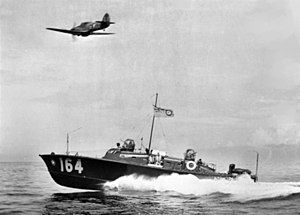Type Two 63 ft HSL
 Whaleback HSL 164 off Colombo with a Hurricane overhead
| |
| Class overview | |
|---|---|
| Name | Type Two 63 ft HSL |
| Builders | British Power Boats |
| Operators | RAF, UK |
| General characteristics | |
| Type | High speed launch |
| Displacement | 21.5 tons |
| Length | 63 ft |
| Beam | 17+1⁄2 ft |
| Draught | 3+3⁄4 ft |
| Propulsion | 3 × Napier Sea Lion each of 500 hp (373 kW) |
| Speed | 36 kn (67 km/h) |
| Range | 500 miles (800 km) |
| Complement | 9 (including captain and a medical orderly) |
| Armament | 2 × 0.303 machine guns |
The 63 foot long Type 2 high speed launch, known as the 'Whaleback' from the distinctive curve to its deck, was a high speed launch class ship used in air-sea rescue to save Allied aircrew from the sea after they were shot down during the Second World War.
History
In the Second World War, the retrieval of pilots and aircrew shot down over the sea around the British Isles was the responsibility of the Royal Air Force Air Sea Rescue Service, (motto: "The sea shall not have them") which coordinated rescues using its own aircraft, aircraft operated by Coastal Command and the Royal Navy and rescue launches operated by the RAF Marine Craft Service and the Royal Navy.

The Type Two was designed in 1937 by Hubert Scott-Paine, founder of the British Power Boat Company at Hythe. Scott-Paine had previously owned the Supermarine Aviation Company, later builders of the Supermarine Spitfire and several flying boat types.
A low set cabin contained the wheel-house, chart room and a sickbay. For defence against enemy aircraft, on top of the cabin were two aircraft-style turrets made by Armstrong-Whitworth each with a single .303 in Vickers machine gun. The mahogany[1] hull was of the hard chine, planing type.
Usage
The Type Two was supplied to RAF marine craft units from the middle of 1940. Around 70 Whalebacks were built for the RAF between 1940 and 1942. They were used throughout the war.
Variants
Following their performance during the Dieppe raid in August 1942, the Type Two was modified. Extra armament was fitted — paired .303 in machine guns mounted either side of the wheel-house and a single 20 mm Oerlikon on the (strengthened) rear deck. Protection was improved by adding anti-shrapnel padding around the forward cabin area.
See also
References
- ^ "Whaleback". British Military Powerboat Trust.
